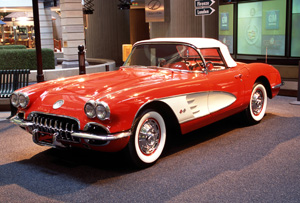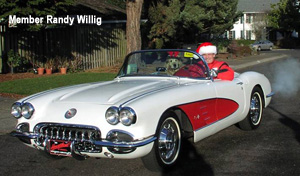 The year was 1960. In October of that year CBS began airing a television show featuring two young men, Martin Milner and George Maharis, driving around the countryside looking for adventure. Both the car and the program were a hit. The show was ‘Route 66’ and the car was, of course, a 1960 Corvette. We may never know if the show helped boost sales but deliveries of the Corvette eventually topped 10,000 for the first time (total run 10,261) that year.
The year was 1960. In October of that year CBS began airing a television show featuring two young men, Martin Milner and George Maharis, driving around the countryside looking for adventure. Both the car and the program were a hit. The show was ‘Route 66’ and the car was, of course, a 1960 Corvette. We may never know if the show helped boost sales but deliveries of the Corvette eventually topped 10,000 for the first time (total run 10,261) that year.The Corvette had already been around for seven years then, not really changing much, just evolving a bit every year. Externally, the 1960 was not much different from a ’59. You could still get whitewall tires (almost all the cars were equipped with that option) and the contrasting color in the cove (surprisingly only a third of buyers selected that one). 1960 was to be the last year that the taillights formed into the rounded fenders. It was to be the last year of the distinctive chromed ‘tooth’ grille also – to be replaced by a wire mesh in 1961. Eight color choices were offered that year. Cascade Green was the most unpopular color appearing in only 140 cars. Today that unpopularity is considered desirable because now it is an extremely rare color to find. A first for the ’60 cars was the introduction of nylon belted tires, replacing the cotton ply that characterized all the previous cars.
Inside the car there was a different seat pattern. Almost 5,275 buyers ordered the new fangled sunshades this year. The most popular interior option for the car was the $102.25 heater closely followed by the Wonderbar AM radio. Two other options that made life easier for drivers of that time were the courtesy lights and windshield washers. As power windows were a rather expensive option, only 544 1960 Corvettes had it. Although the optional hardtop was pricey for the day at $236.75 over half of the cars were equipped with them.
Mechanically, there was little change but it now had a top engine choice of a 283 cubic inch fuel injected (fuelie) engine putting out 290 hp. There was also a 283 fuel injected engine that put out 250 hp for the same price ($484.20) and the base engine, a carbureted 283 producing a modest 245 hp. The 290 hp outsold the 250 hp engine almost 8:1. 0 – 60 times was in the mid 5 seconds. But the most popular engine of the day was the carbureted 270 hp that only cost $182.95 and can be found in about a quarter of the 1960 run. With solid lifters and an 11.0:1 compression the most potent fuelie gave ample power for the enthusiast. But the Powerglide transmission could not handle that kind of torque, so only the manual 4 speed transmission was available with fuel injection. That gearbox got new aluminum clutch housings and an optional thermostatically controlled fan. About half of the buyers opted for the positraction as well. Surprisingly only 119 buyers opted for the heavy-duty brake and steering to go along with the performance, even given the reasonable price of $26.99. Metallic brakes were optional too but less than ten percent thought it was worthwhile. Along with performance, handling got a boost with the introduction of a larger-diameter front and rear anti-sway bars. The anti-sway bars gave the car a smoother ride and more neutral handling.
As with any classic, condition determines the car’s price. Of course we are talking about a 40 year old car now. The regular warnings apply for the purchase of any classic – do your homework. Know your seller. Research the history of the car. Are you buying it as an investment? Will it be a weekend driver? A show circuit car? A daily driver? A restoration project? Using it in racing? Are you comfortable with insuring it? Do you know the risks? How will you be storing it? Does your spouse or significant other agree with the purchase? The last question is how do I compare the different cars? I won’t go into parts cars or restoration specials so you have four categories to consider:
• Good but needs work
• Very good
• Original or restored
• Show car/concours
Be careful of sellers describing their cars as better than they are. You just end up wasting a lot of time traveling and being disappointed. If you are picky and the car has been in competitions before, demand to see the NCRS certificate, judging sheets, ribbons won, etc. Check with other owners of the year or years you are looking for. In this case look for C1 members and examine their cars. If you don’t know it yet most members are very friendly and willing to help a fellow member with the ins and outs of their cars. As a matter of fact you might find a car that a member is considering selling. There are a number of dealers and brokers out there. On the whole they are honest businessmen with legitimate cars. Unfortunately there might be a few shady ones so be careful before you part with your hard-earned cash. Good luck and………..have fun.
PS: According to legend, in 1960, Bill Mitchell was deep sea fishing in the Bahamas. Upon landing a shark he was inspired by the shark’s lines as the basis of the upcoming experimental XP-775, the eventual successor to the current Corvette. The car is eventually even named the Sting Ray (later years changed the spelling to Stingray) …..and the rest is history. One shudders to think what would have happened if he had landed a whale instead.
’60 VETTE FACTS
|
|
|
VEHICLE IDENTIFICATION NUMBER
|
00867S100001 through 00867S110261
|
|
ENGINE
|
BASE ENGINE
Type: V-8
Bore and stroke: 3.87 x 3.00 in.
Displacement: 283 cid
Brake hp: 230 at 4800 rpm.
Carburetor: Carter Type WCFB 4-bbl
OPTIONAL ENGINES:
283-cid/245-hp w/ two 4-bbl. carb
283-cid/270-hp w/ two 4-bbl. carb
283-cid/275-hp w/Rochester fuel injection
283-cid/315-hp w/Rochester fuel injection
|
|
VITAL STATS
|
Convertible
Original Price: $3,872
Production: 10,261
Wheelbase: 102 in.
Length: 177.2 in.
Tires: 6.70 x 15
|
|
COOL STUFF
|
• All 1960 fuel injected engines required manual transmissions.
• Last year with heavy "teeth" in grill.
|